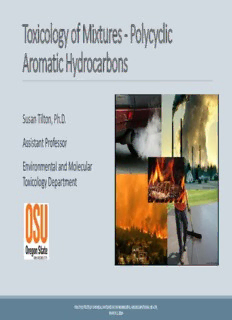
Toxicology of Mixtures - Polycyclic Aromatic Hydrocarbons PDF
Preview Toxicology of Mixtures - Polycyclic Aromatic Hydrocarbons
Toxicology of Mixtures - Polycyclic Aromatic Hydrocarbons Susan Tilton, Ph.D. Assistant Professor Environmental and Molecular Toxicology Department HEALTH EFFECTS OF CHEMICAL MIXTURES IN ENVIRONMENTAL AND OCCUPATIONAL HEALTH, MARCH 2, 2016 Outline What are PAHs? common sources, exposure, diversity of chemical class, toxicity, mechanism(s) of action PAH risk assessment: Past, present and future Regulation of PAHs as mixtures Current considerations and future needs for evaluating risk Whole mixture approach for predicting carcinogenic risk of PAH mixtures in vitro What are PAHs? Polycyclic aromatic hydrocarbons (PAHs): Sources and Uses Ubiquitous contaminants occurring naturally (crude oil) or created from incomplete combustion and released from both natural (forest fires) or anthropogenic (burning of fossil fuels) Natural Forest fires Oil seeps Volcanos Anthropogenic Wood burning Internal combustion engine (vehicle exhaust) Cigarette smoke Roofing/coal tar products Electric power generation Petroleum Polycyclic aromatic hydrocarbons (PAHs): Sources and Uses PAHs are not synthesized for industrial purposes, but can be used as intermediaries in manufacturing (examples below) ◦ Acenaphthene: manufacture of dyes, plastics, pigments, pharmaceuticals and pesticides ◦ Anthracene: manufacture of dyes and pigments;diluent for wood preservatives; ◦ Fluoranthene: manufacture of dyes, pharmaceuticals and agrochemicals. ◦ Fluorene: manufacture of dyes, pigments, pesticides, thermoset plastic and pharmaceuticals; ◦ Phenanthrene: manufacture of pesticides and resins ◦ Pyrene: manufacture of pigments Polycyclic aromatic hydrocarbons (PAHs): Routes of exposure Humans primarily exposed to PAHs as mixtures via consumption/ingestion, inhalation and dermal exposure routes Polycyclic aromatic hydrocarbons (PAHs): Chemical characteristics Two or more aromatic rings with a pair of carbon atoms shared, highly lipophilic 16 priority EPA PAHs (ATSDR, 2005) Toxicity Potential for human exposure Frequency of occurrence at hazardous waste sites Available information Include probable and known human carcinogens Polycyclic aromatic hydrocarbons (PAHs): Chemical characteristics Broader class of polycyclic aromatic compounds >1500 chemicals total Diverse structural features Includes both unsubstituted and substituted forms O-, N-, S-, CH3- Little data available on sources, exposure, toxicity, mechanisms Consideration of PAH mixtures Diesel exhaust Coal tar Cigarette smoke Polycyclic aromatic hydrocarbons (PAHs): Toxicity Carcinogenicity – Include Class I known human carcinogens (benzo[a]pyrene, diesel exhaust, occupational exposure to coal/coke PAH mixtures) and Class 2A/B probable/possible carcinogens Teratogenicity – animal and epidemiology studies Genotoxicity – via metabolism in animal and human cells Immunotoxicity – suppression Reproductive toxicity – e.g. reduced ovarian size Polycyclic aromatic hydrocarbons (PAHs): Mechanism of action General overview Luch (2005) Nature Rev. Cancer. 5:113-125. doi: 10.1038/nrc1546
Description: